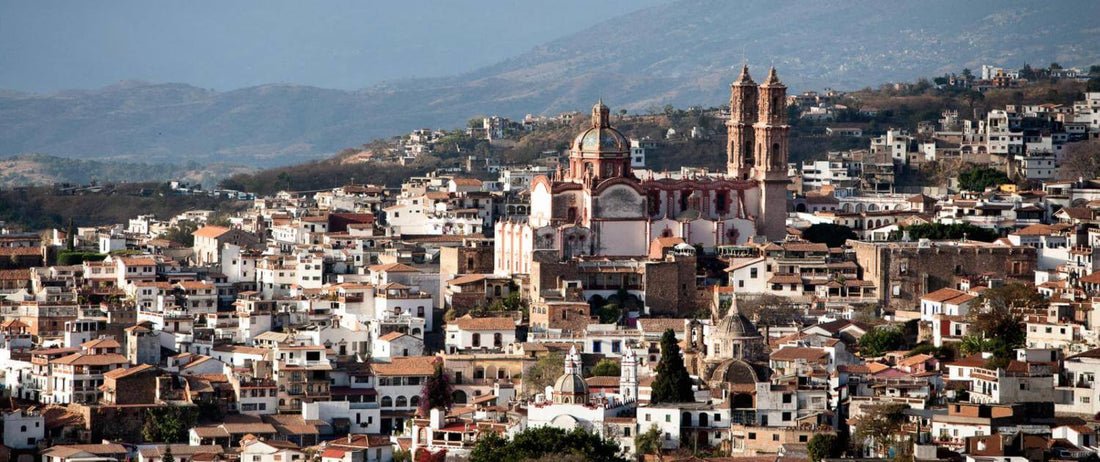
William Spratling and the History of Taxco Silver
by Dani Chavez
" Spratling's innovative work influenced a generation of Mexican and American designers."
Only a few outside the jewelry-collecting world are familiar with Taxco, let alone aware of the rich silver history that adorns the beautiful city. Taxco de Alarcón, most commonly referred to as Taxco, is a small town located 106 miles southwest of Mexico City. The name comes from the Nahuatl meaning "place of the ballgame," which ominously refers to a morbid Aztec game involving rings and skulls.

Taxco Collar Necklace and Statement Ring. Image: The Gemmary
The native Mesoamericans' Taxco was about 6 miles south of the current Taxco. The governor of the Aztecs resided there and oversaw the collection of tributes from the seven districts. However, Spanish conquistador Hernán Cortés decided his Taxco would be north, where silver was abundant.
The Spanish began mining the large silver lodes in the 1530s and worked the diggings until the Mexican Independence of 1821. For 100 years, the sleepy town and mines were relatively unknown to the world until an American named William Spratling moved to Taxco in 1929 to write.

William Spratling, 1935.
By Juan Guzman - Original publication: Grafico Mexico D.F. Av. Morelos 89-Dep. 8 Immediate source: Photo provided by Penny C. Morrill. Author of "William Spratling and the Mexican Silver Renaissance." The photo is also included in this book on page 224. Fair use, https://en.wikipedia.org/w/inPex.php?curid=37684199.
Spratling was an assistant professor of architecture at Tulane University, a well-established department with a focus on Mesoamerican studies. From 1926 to 1929, he spent his summers lecturing on colonial architecture in Mexico City and touring the country in his free time.
Spratling eventually settled in Taxco and wrote a novel titled Little Mexico. When book sales failed to meet expectations, the US ambassador to Mexico encouraged William to create silver jewelry to sell on the thriving tourist market.

Taxco Bypass Cuff, Chain Link Bracelet, and Bypass Ring. Image: The Gemmary
In 1931, Spratling hired two local Plateros, or silversmiths, to teach him the trade techniques. Soon after this, he began crafting his first pieces at his kitchen table with silver from coins.
As luck would have it, that same year, a brand new highway from Mexico City to Acapulco was completed, linking the tiny town of Taxco to the capital city. Tourists flocked to the quaint village, and Spratling's jewelry became extremely popular.

Taxco Amethyst Link Bracelet, Rings, and Day/Night Earrings
Spratling's early influences were native Mexican designs and motifs, spurred by the recent archaeological significance of Monte Alban. Throughout his career, William incorporated motifs ranging from Mayan to Art Deco, Jazz era, astrological, and mythological figures, as well as depictions of ranch life and natural elements.
Artemio Navarette and Alfonso Mondragon were the first Plateros hired by Spratling, and they assisted him in establishing his apprenticeship program shortly after. The first apprentices were the Castillo brothers, who learned English daily and hung around the shop to observe the silversmiths.
 Taxco Azuremalachine Earrings and Bangle Cuff Bracelets. Image: The Gemmary
Taxco Azuremalachine Earrings and Bangle Cuff Bracelets. Image: The Gemmary
Other young men stepped forward to learn the trade, and the program took off. Antonio Pineda, Margot de Taxco, and Hector Aguilar are notable apprentices who went on to form their own shops.
During World War II, the European import and export of refined and luxury goods ground to a halt. As a result, American high-end stores and chains had to find products elsewhere. Taxco silver became highly fashionable, and many of the period's celebrities were fond of vacationing in Taxco's colonial charm.

Sombrero Bypass Cuff, Button Earrings, and Scalloped Collar Necklace. Image: The Gemmary
William Spratling, the father of the modern Mexican jewelry movement, produced jewelry until his untimely death in 1967. Spratling's enduring legacy will undoubtedly linger in the glistening silver hills of Taxco and in the hands of the Plateros, who continue to work today.
To learn more about dating Taxco jewelry, read our blog post here.
